Previously on Baxter Building: Stan Lee and Jack Kirby introduced some of the greatest comic book heroes the world had ever seen, and then went on to prove that, while the series has a lot going for it, bringing villains back for second go-rounds wasn’t necessarily one of those things. You can find the first two episodes here.
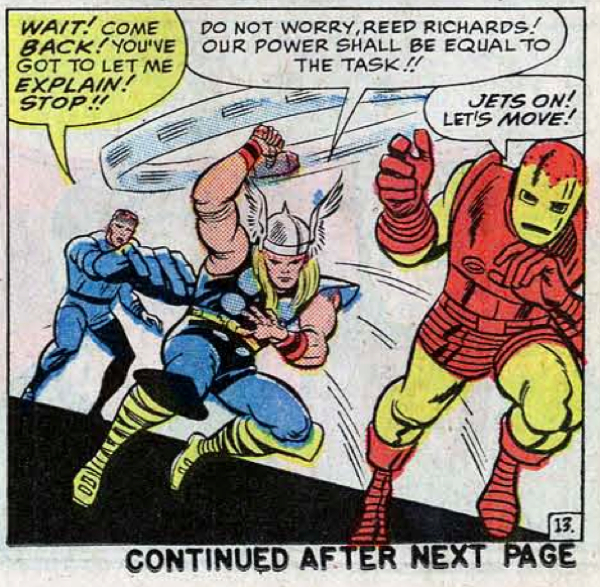
I’ll be honest: for awhile there, it really looked like this was the episode that was never going to happen, due to technical problems during recording, editing and even now, as I write these show notes. (To that end, I apologize for a “MARVEL” watermark in one of the images — I don’t have access to Marvel Unlimited right now, so you’re getting them straight from the PDFs Jeff and I are reading, this time around.) Nevertheless, here are two hours of Jeff and I suggesting Mad Thinker revamps, talking about the greatness that is Jack Kirby and complaining about Reed Richards. In other words, my friends, another Baxter Building for you to enjoy (and if you don’t want to enjoy it here, then there’s always Stitcher and iTunes to fulfill your listening needs.) Show notes (and more!) under the jump.
But before we get there, there’s always this moment of greatness from Icarus’ 1972 album The Marvel World of Icarus. I swear to God, I so wish I could play any musical instrument so that we could persuade Jeff to sing a cover version of this. (Thanks to Jarrett Kobek for passing this along. It’s amazing.)
0:00:00-0:03:13: Learn the shameful secret of the third episode of Baxter Building! Somewhat suitably for an episode that features the first (and second!) appearance of Diablo, it can be argued that this episode is cursed — we had an unusually tight recording schedule for this one, and immediately lost 30 minutes to Skype problems. That means that we didn’t get to all of the issues promised this time around, with both the second Fantastic Four Annual and #36 of the regular series having to be sacrificed for expediency. They’ll show up next time, I promise! (I also lost Internet for more than a day at home during the editing process, meaning that I had to upload it later than intended, weirdly enough. Like I said, cursed.)
0:03:14-0:04:14: Listen to me teasing people about how great Annual #2 is! And it is! But we really thought that we could get there at the time, in our innocence.

0:04:15-0:09:02: We start with “The Fabulous Fantastic Four Presents: The Battle of the Century, The Hulk vs. The Thing!” and watching Lee and Kirby shake off some previous uncertainty to come up with… some new uncertainty, at least when it comes to what Ben Grimm really wants out of life, other than Alicia Masters. (There’s some mention of #30 ahead of time, but we’ll get there soon enough.)
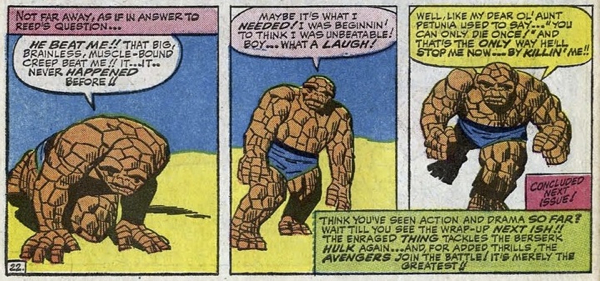
00:09:03-0:18:20: Who knew that there was actually a great Thing/Hulk fight scene? And yet, here it is, thanks to some great synergy between Stan Lee and Jack Kirby, and especially some great escalation and pacing from Kirby. You also get to hear Jeff declare his preference for “Thing in a Motorboat,” and it’s not a euphemism, and did Stan Lee understand the difference between sleeping and being in a coma? Plus — the origin of a Stan Lee cliche? Maybe, but it’s something that really, really works here.
0:18:21-0:30:09: “Issue 26 is kind of a mess,” I say, and I blame it pretty much on the Avengers. That’s not fair, though; the real problem is the shift in the story’s focus, not Earth’s Mightiest Heroes themselves. The first meeting between the FF and the Avengers is a prime slice of Stan Lee’s “hey, our heroes are just like real people — real, annoying, bickering asshole people!” philosophy, and it’s something that completely overwhelms everything that’s been set up in the previous issue. Jeff points out Sue Storm’s Daddy Issues and how they related to Reed Richards, making everything creepy, and both of us enjoy the understated melancholy of Hulk driving a Subway Car:
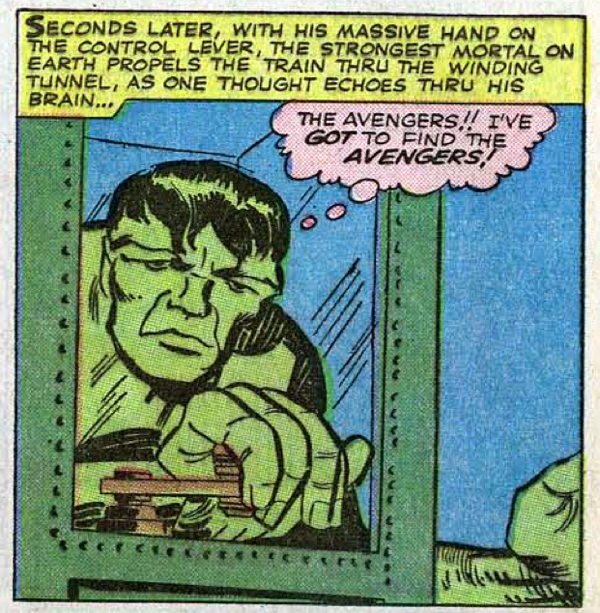
Oh, Hulk.
0:30:10-0:47:22: The Sub-Mariner returns to demonstrate that he doesn’t understand the meaning of consent — and this from one of Tumblr’s favorite superheroes! — and delivers the most disappointing Sub-Mariner issue yet in the process. (Don’t worry, an even worse one is on the way this episode!) Lee and Kirby slip out of synch again, and the result is something that’s very noticeable. Is the problem that Kirby and Lee have a different amount of attention given over to matters of continuity? Also: The utter pointlessness of Doctor Strange and his deus ex machine powers, and the question of whether or not Reed Richards’ inability to deal with emotional matters turns his body into bright red electricity. Exhibit A, below:
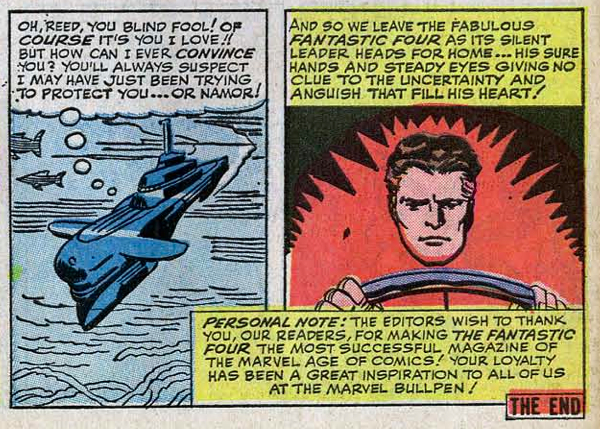
Also, those who wonder where the title of this episode comes from, this is the issue that will explain it all. For those who’ve always wanted to hear Jeff and I discuss whether or not “sloppy seconds” had an entirely non-sexual meaning in the 1960s, this is your episode. Quite how we ended up at this point, I have no idea. On the plus side, we identify another Stan Lee’s Alpha Male trope, which is his inability to have his characters actually lose.
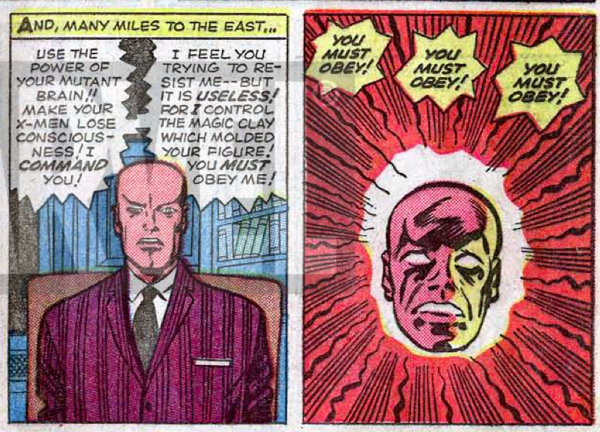
0:47:23-1:03:16: Is “Leff Jester” the sensational character find of 2015? You’ll find out here, as Jeff and I come up with a brand new take on the Mad Thinker that any Marvel writers listening can use whenever the hell they want. It’s certainly better than the passive aggressive version of the character as presented in this issue, wherein he teams up with the Puppet Master to… well, utterly waste a great opportunity to use the X-Men to utterly destroy the FF, really. Also! Discover how slavish to their leader’s commands the original X-Men were! Learn that Jeff Lester recognizes human beings only by their hair or lack thereof and what color clothes they wear! Revel in the sheer greatness of his Patrick Stewart impersonation! Really, it’s all here as we deconstruct FF #28, and our deconstruction is also far, far more entertaining than the issue itself — we’re not boasting, it’s just a pretty dull issue.
1:03:17-1:12:50: What happens when Lee and Kirby try to revisit everything about their completely victorious FF #13? The answer is, apparently, “something disappointing.” The return of Red Ghost, His Super-Apes and the Watcher proves to be underwhelming enough that Jeff and I go off on a tangent about whether or not George R.R. Martin’s middle initials stand for Reed Richards. “I wouldn’t necessarily rule it out,” says Jeff, being a little bit too generous about the crackpot theory. I bring up the possibility of “future nostalgia” for Lee and Kirby’s later collaborations is responsible for raising expectations that the story can’t quite meet, while Jeff points out that the opening of the story is way more interesting than what follows, and why that might be.
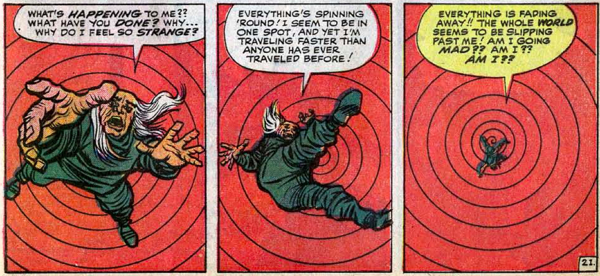
1:13:00-1:18:01: Is Fantastic Four in a rut at this point? What defines a rut, anyway? Jeff argues that, when the Frightful Four shows up in #36, the book hits its first real rut, and signs are already apparent that it’s on the way, but I’m unconvinced. (We both agree that, if it is a rut, it’s a pretty enjoyable rut, because it’s better than some of the issues we’ve dealt with in the previous couple of episodes.) When Lee and Kirby come up with the “anti-Fantastic Four” idea, do they just stop trying for awhile? “It feels like Lee and Kirby trying to do the same thing over and over again, hoping to get different results,” Jeff says. Is FF #29 the start of that?
1:18:02-1:22:02: Even if the book as a whole is in a rut, we talk about Kirby leveling up in this batch of issues. I suggest that Chic Stone’s inks help a lot, but Kirby as most people recognize him is beginning to appear in these issues. Also discussed: the problems with Sue Storm’s hair under the Kirby/Stone team.
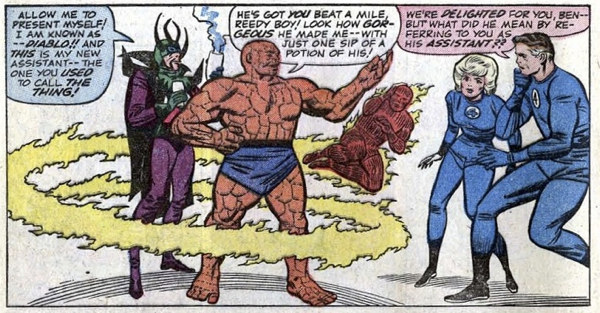
1:22:03-1:30:13: Fantastic Four #30 is definitely the most “Kirby” issue of the run to date, with both Jeff and I agreeing that it could almost be an issue of The Demon from the ’70s in many ways (and not just because it’s set in Transylvania). We’ve skirted close to fairy tale logic in the FF before, but this fully embraces that kind of thinking, with Diablo pretty much being the Devil himself, albeit a Devil that’s more of a dick than outright evil. “It kind of only works if you ignore all the character work that’s been done up to this,” I say, but if you’re able to do that, there’s an awful lot to enjoy with this issue — including the strangest Ben Grimm yet, who’s more than a little disturbing, but at least he kind of gets a redemption after losing to the Hulk six months earlier. Kind of.
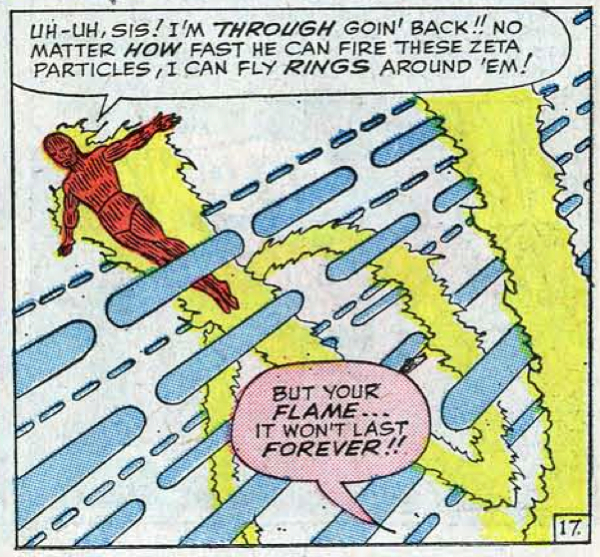
1:30:14-1:36:44: The Mole Man returns in FF #31, and in a staggering turnaround, it’s actually a surprisingly good issue. Yes, a Mole Man issue that’s not embarrassing for everyone involved! There’s a lot of genuinely great Kirby work in this issue, too, which Jeff and I talk about — with his abstractions beginning to come to the fore in an exciting way. Between the visual spectacle and the soap operatics of the mysterious stranger who can ruin Sue Storm’s life, it’s Lee and Kirby getting everything they could possibly want out of the comic in their own ways, without stepping on each other’s toes. (Also, we do an issue in six minutes! If we could do that more often, I think everyone would be happy.)
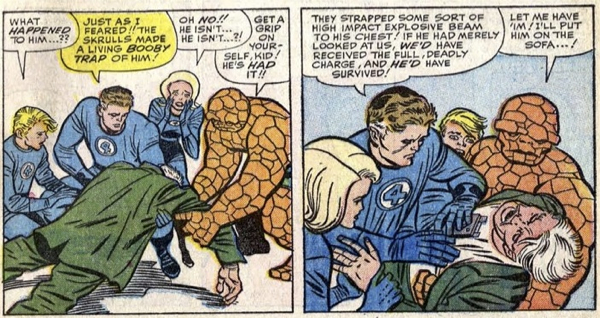
1:36:45-1:48:39: “This is Kirby being very Kirby,” and that means that you’re getting some great comics in Fantastic Four #32 — especially with Lee once again bringing the melodrama (and characters showing their amazing dickishness) the way you want it, true believer. Jeff wonders why the Skrulls don’t live up to their true potential — something that’s a running theme in Fantastic Four to date, let’s be honest— while we marvel at Reed’s really shitty ability to plan for possibilities that he’s managed to foresee. We also get to see the birth of another Stan Lee cliche, as a loved one gets to die a noble death in front of a series’ main character after delivering a motivational speech. History is being made in front of your eyes, dear Whatnauts!
1:48:40-1:51:06 Speeding along to FF #33, and although we spend very little time on the return of Namor, I think that’s entirely appropriate. It’s the Sub-Mariner defending Atlantis from the forces of Attuma, and outside of the work of Jack Kirby, there’s very little to say about it.
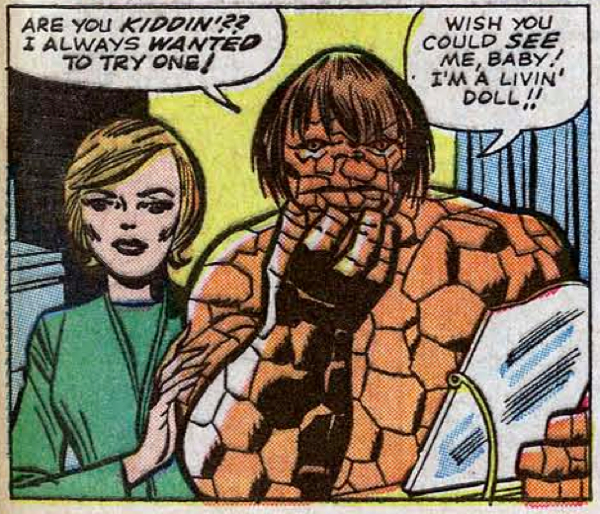
1:51:07-1:53:53 We’re rushing through the issues by this point, and it’s a shame, because Fantastic Four #34 is something that we both could have spent a long time on if we’d had the time. It brings the fairy tale influence of earlier issues to the fore in a wonderful way and lets both Lee and Kirby work out their inner sentimentalists to great effect. Plus, Beatle wigs!
1:53:54-1:57:12: Dragon Man makes his debut in FF #35, and Jack Kirby will make you believe in him in a way you might not expect, and Jeff continues to reveal his unexpected fetishes when it comes to Sue Storm’s portrayals. The issue “feels pretty perfect,” says Jeff, and he’s not wrong, while I go back to the fairy tale well one more time, which leads to…
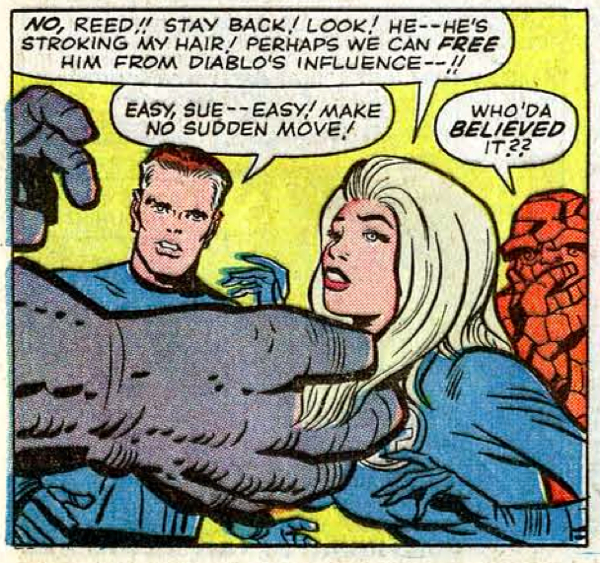
1:57:13-2:00:05: Jeff takes that thought further by suggesting that the fairy tale stories are examples that inspire Reed his way to move forward as a character, while I wonder whether that’s a redemptive, transformative element at play in everything that’s been going on in the last few issues, at least when it comes to Reed’s characterization — not that Lee or Kirby were necessarily aware of it at the time. (Jeff references the Great American Novel site once again, which is highly recommended.) Look at us throwing out these concepts as we’re speeding through things towards a deadline — we’re almost Lee and Kirby ourselves!
2:00:06—end: In which we tease the next episode of Baxter Building, apologize for not getting through everything this time around, and tell you where you can find us on this there Internet should you be lookin’. (That’d be Tumblr, Patreon and Twitter, in case you’re wondering.) Next time, we’ll try not to be so cursed, and to also run longer to get back on track in terms of issues. No, really!


Oh, and!
http://theworkingdraft.com/media/podcasts/Baxter_Building_3.mp3
(just in case you need it…)
Thanks for another excellent edition, I don’t know why, I just felt COMPELLED to listen (there are still funny jagged lines floating near my heid, which suddenly looks like a massive load of vanilla ice cream).
I was amused to see that the Great American Novel site also references this very podcast!
Chris Tolworthy was kind enough to give us the thumb’s up after our very first episode!
https://waitwhatpodcast.com/baxter-building-ep-1-what-in-blazes-does-it-mean/#comment-2873
I can’t speak for Graeme, but I adore his site…and made it a point not to look at it once we started our read-through. As it is, I’m sure I unconsciously parrot a ton of his points but believe me it would much, much worse if I gave into temptation to see his remarks after I finish a particular issue (a temptation which occurs pretty much every issue). So having him reference us positively—or heck, even negatively—is hugely gratifying for me.
Re: the Sue Storm image – is it because the art here makes her look weirdly like Emilia Clarke in Game of Thrones (down to the dark eyebrows)?
I was surprised you had such a low opinion of the Namor/Attuma issue. I found it one of the more enjoyable of the recent batch (along with the Dragon Man issue), though that may be because Kirby drawing crazy armor and weapons hits such a sweet spot.
The Thing/Hulk battle is pretty epic, though I do agree that the finale kind of craps all over it.
Is there an in-continuity explanation of what makes Philip Masters such a bad step-dad? Clearly, his world-conquering, people controlling ways are wrong, but what did he do to Alicia? Granted, he endangered her by getting her to cosplay Sue and involving her in his first plan. However, in a series where Reed, Sue and Ben are all complicit in allowing Johnny to go into space (given Ben and Alicia’s relationship let’s all agree Alicia is significantly older than Johnny. Please.) how bad is that? We don’t know when her mother died, or what age Alicia was when she died. Did he keep her out of institutional care?